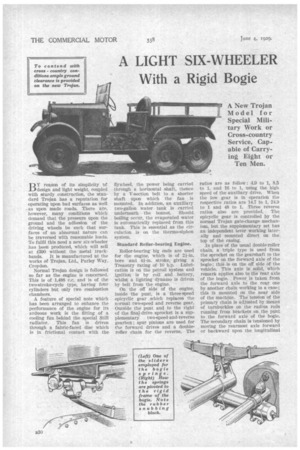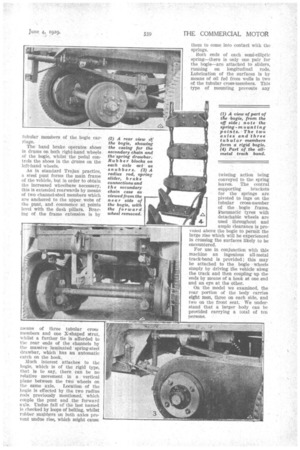A LIGHT SIX-WHEELER With a Rigid Bogie
Page 56

Page 57

If you've noticed an error in this article please click here to report it so we can fix it.
A New Trojan Model for Special Military Work or Cross-country Service, Capable of Carrying Eight or
Ten Men.
D Y reason of its simplicity 'of L./design and light weight, coupled with sturdy construction, the standard Trojan has a reputation for operating upon bad surfaces as well as upon made roads. There are, however, many conditions which demand that the pressure upon the ground and the adhesion of the driving wheels be such that surfaces of an abnormal nature can be traversed with reasonable loads. To fulfil this need a new six-wheeler has been produced, which will sell at £390 without the metal trackbands. It is manufactured at the works of Trojan, Ltd., Purley Way, Croydon.
Normal Trojan design is followed so far as the engine is concerned. This is of 1,488 c.c. and is of the two-stroke-cycle type, having four cylinders but only two combustion chambers.
A feature of special note which has been arranged to enhance the performance of the engine for its arduous work is the fitting of a cooling fan behind the special Still radiator. This fan is driven through a fabric-faced disc which is in frictional contact with the flywheel. the power being carried through a horizontal shaft, thence by a 17-section belt to a shorter shaft upon which the fan is mounted. In addition, an auxiliary two-gallon water tank is carried underneath the bonnet. Should boiling occur, the evaporated water is automatically replaced from this tank. This is essential as the circulation is on the thermo-siphon system.
Standard Roller-bearing Engine.
Roller-bearing big ends are used for the engine, which is of 2k-in. bore and 4k-in. stroke, giving a Treasury rating of 10 h.p. Lubricatien is on the petrol' 'system and ignition • is by coil and battery, whilst a lighting dynamo is driven by belt from the engine.
On the off side of •the engine, inside the punt, is a three-speed epicydic gear which replaces the normal two-speed and reverse gear. Outside the punt and to the right of the final-drive sprocket is a supplementary two-speed-and-reverse gearbox ; spur pinions are used, for the forward drives and a doublerollor chain for the reverse. The ratios are as follow: 4.9 to 1, 8.3 to 1, and 16 to 1, using the high speed of the auxiliary drive. When the low gear is in operation the respective ratios are 14.7 to 1, 24.9 to 1 and 48 to 1. Three reverse ratios also are provided. The epieyclic gear is controlled by the normal Trojan gate-change mechanism, but the supplementary set has an independent lever working laterally and mounted direct on the top of the casing.
.1a place of the usual double-roller chain, a triple type is used from the sprocket on the gearshaft to the sprocket on the forward axle of the bogie; thii.is on the off side of the vehicle. This axle is solid, which remark applies also to the rear axle of the bogie. Power is taken from the forward axle _to the rear one by another chain working in a case; this is mounted on the near side of the machine. The tension of the primary chain is adjusted by Means of turnbuckles on the radius rods running from brackets on the mint to the forward axle of the bogie. The secondary chain is tensioned by moving the rearmost axle forward or backward upon the longitudinal tubular members of the bogie carriage.
The hand brake operates shoes in drums on both right-hand wheels of the bogie, whilst the pedal controls the shoes in the drums on the left-hand wheels.
As in standard Trojan practice, a steel punt forms the main frame of the vehicle, but in order to obtain. the increased wheelbase necessary, this is extended rearwards by means of two channel-steel members which are anchored to the upper webs of the punt, and commence at points level with the dash pillars. Bracing of the frame extension is by
means of three tubular cross members and one X-shaped strut, whilst a further tie is afforded to the rear ends of the channels by the massive laminated spring-steel drawbar, which has an automatic catch on the hook.
Much interest attaches to the bogie, which is of the rigid type, that is to say, there can be no relative movement in a vertical plane between the two wheels on the same axle. Location of the bogie is effected by the two radius rods previously mentioned, which couple the punt and the forward axle. Undue fall of the last named is checked by loops of belting, whilst rubber snubllers on both axles prevent undue rise, which might cause them to come into contact with the springs.
Both ends of each semi-elliptic spring—there is only one pair for the bogie—are attached to sliders, running on longitudinal rods. Lubrication of the surfaces is by means of oil fed from wells in two of the tubular cross-members. This type of mounting prevents any twisting action being conveyed to the spring leaves. The central supporting brackets for the springs are pivoted to lugs on the tubular cross-member of the bogie frame. Pneumatic tyres with detachable wheels are used throughout and ample clearance is pro vided above the bogie to permit the large rise which will be experienced in crossing the surfaces likely to be encountered.
For use in conjunction with this machine an ingenious all-metal track-band is provided; this may be attached to the bogie wheels simply by driving the vehicle along the track and then coupling up the ends by means of a hook at one end and an eye at the other.
On the model we examined, the rear portion of the body carries eight men, three on each side, and two on the front seat. We understand that a larger body can be provided carrying a total of ten persons.




















































































































